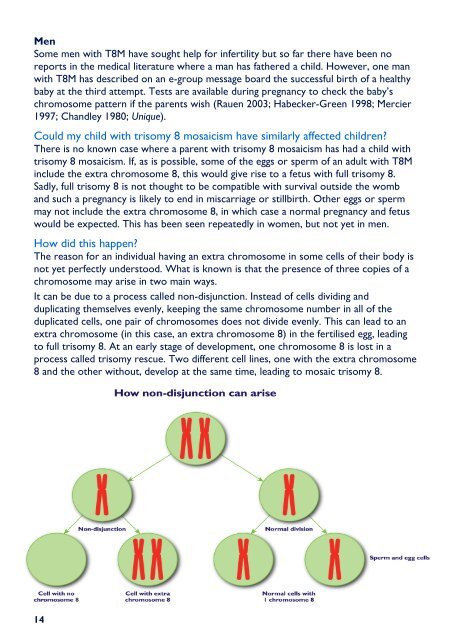Trisomy 8 mosaicism in adults FTNW.pub - Unique - The Rare ...
Trisomy 8 mosaicism in adults FTNW.pub - Unique - The Rare ...
Trisomy 8 mosaicism in adults FTNW.pub - Unique - The Rare ...
Create successful ePaper yourself
Turn your PDF publications into a flip-book with our unique Google optimized e-Paper software.
Men<br />
Some men with T8M have sought help for <strong>in</strong>fertility but so far there have been no<br />
reports <strong>in</strong> the medical literature where a man has fathered a child. However, one man<br />
with T8M has described on an e-group message board the successful birth of a healthy<br />
baby at the third attempt. Tests are available dur<strong>in</strong>g pregnancy to check the baby’s<br />
chromosome pattern if the parents wish (Rauen 2003; Habecker-Green 1998; Mercier<br />
1997; Chandley 1980; <strong>Unique</strong>).<br />
Could my child with trisomy 8 <strong>mosaicism</strong> have similarly affected children?<br />
<strong>The</strong>re is no known case where a parent with trisomy 8 <strong>mosaicism</strong> has had a child with<br />
trisomy 8 <strong>mosaicism</strong>. If, as is possible, some of the eggs or sperm of an adult with T8M<br />
<strong>in</strong>clude the extra chromosome 8, this would give rise to a fetus with full trisomy 8.<br />
Sadly, full trisomy 8 is not thought to be compatible with survival outside the womb<br />
and such a pregnancy is likely to end <strong>in</strong> miscarriage or stillbirth. Other eggs or sperm<br />
may not <strong>in</strong>clude the extra chromosome 8, <strong>in</strong> which case a normal pregnancy and fetus<br />
would be expected. This has been seen repeatedly <strong>in</strong> women, but not yet <strong>in</strong> men.<br />
How did this happen?<br />
<strong>The</strong> reason for an <strong>in</strong>dividual hav<strong>in</strong>g an extra chromosome <strong>in</strong> some cells of their body is<br />
not yet perfectly understood. What is known is that the presence of three copies of a<br />
chromosome may arise <strong>in</strong> two ma<strong>in</strong> ways.<br />
It can be due to a process called non-disjunction. Instead of cells divid<strong>in</strong>g and<br />
duplicat<strong>in</strong>g themselves evenly, keep<strong>in</strong>g the same chromosome number <strong>in</strong> all of the<br />
duplicated cells, one pair of chromosomes does not divide evenly. This can lead to an<br />
extra chromosome (<strong>in</strong> this case, an extra chromosome 8) <strong>in</strong> the fertilised egg, lead<strong>in</strong>g<br />
to full trisomy 8. At an early stage of development, one chromosome 8 is lost <strong>in</strong> a<br />
process called trisomy rescue. Two different cell l<strong>in</strong>es, one with the extra chromosome<br />
8 and the other without, develop at the same time, lead<strong>in</strong>g to mosaic trisomy 8.<br />
14

















